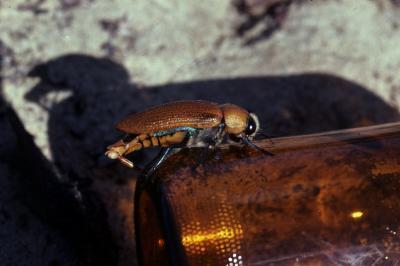Nothing says science like a beetle humping a beer bottle - and it earned Professors Darryl Gwynne and David Rentz a coveted Ig Nobel prize.
If you have been living under the science equivalent of a rock, you may not know the Ig Nobel prizes are parodies of the Nobel kind and are presented annually by the Annals of Improbable Research.
As they tell it, Gwynne and Rentz were working in Australia two decades ago when they noticed something that has never happened to us, even with the worst beer goggles. "We were walking along a dirt road with the usual scattering of beer cans and bottles when we saw about six bottles with beetles on top or crawling up the side. It was clear the beetles were trying to mate with the bottles."
The male was Julodimorpha bakewelli, an Australian jewel beetle, and he died rather than give up. There was a reason. The big, brown bottles (they call them stubbies Down Under) resemble a "super female" jewel beetle, even the light they reflected resembled female wing covers. The bottles proved irresistible to males and they fried to death in the sun, were eaten by hungry ants or had to be physically removed by the researchers.

A male Australian jewel beetle attempts to mate with a "stubby" beer bottle. Credit: Darryl Gwynne
Their 1983 paper in the journal of the Entomological Society of Australia and the U.K.-based Antenna on the subject, "Beetles on the Bottle: Male Buprestids Mistake Stubbies for Females", finally got them the award.
"I'm honoured, I think," Gwynne says. "The awards make people think, and they're a bit of a laugh. Really, we've been sitting here by the phone for the past 20 plus years waiting for the call. Why did it take them so long?"




Comments